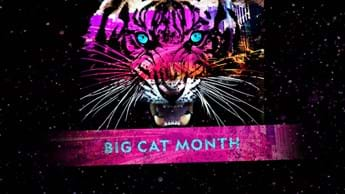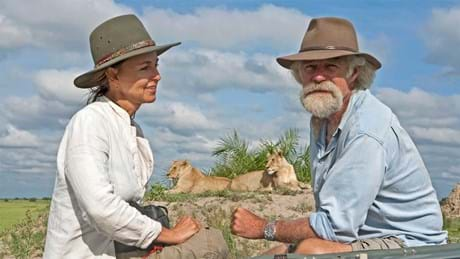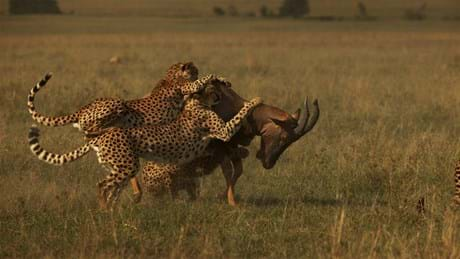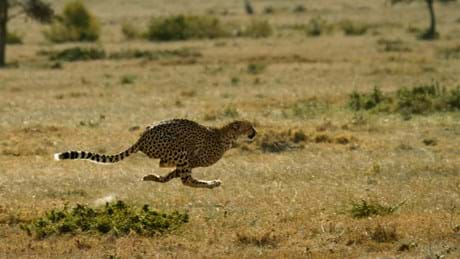Filmmakers Dereck and Beverly Joubert kick off Big Cat Month on DStv
Celebrate Big Cat Month on National Geographic Wild (DStv Channel 182) with filmmakers Dereck and Beverly Joubert’s The Way of The Cheetah, and more.

“While we are often put in a box of being wildlife filmmakers, storytellers and photographers, that’s not really what we do,” insists Dereck Joubert. “What we do is that we tell stories that are parables for human life. And the stories that we draw from the big cats are really stories that serve us personally very well in our lives. There’s not a single 1 of them that doesn’t show up every single day, and do what it does with an intense focus and dedication. That never-give-up resilience is what we take away.”
Dereck and his filmmaking partner wife Beverly Joubert’s passion for storytelling shines through the 35 films they’ve made for National Geographic, 12 books and around 6 scientific papers. They film in the wild roughly 300 days a year (barring lockdowns) and observe so closely that they have even counted a leopard’s spots (840 for Legadema, the star of Eye of The Leopard, which we can see on Sunday, 20 February).
Like the big cats, they have beaten the odds to keep going back into the field. “I’ve been stung by scorpions 21 times, I’ve had 18 bouts of malaria, we’ve been hit by elephants 4 times, we’ve had 3 buffalo attacks (during 1 of which in 2017, Beverly was gored through the underarm and up through her cheek, leaving her with over 20 bone fractures), I’ve been bitten by 3 deadly snakes, I’ve crashed 3 aeroplanes… but other than that it’s been really easy going,” Dereck jokes. “Talk about a cat with 9 lives! We feel like we’ve surpassed that,” Beverly says, smiling.
This Big Cat Month, the Jouberts have a new story to tell us in Way of The Cheetah: the tale of Imani, whose name means Faith, and of her brushes with a rare 5-male coalition of male cheetahs who’re hunting together as a pack. “Conservation starts with celebration,” says Dereck. “Unless we love and fall in love with these animals, and I hope that people will fall in love with Imani and her 4 cubs, we’re never going to save them.”
Watch National Geographic WIld now Set a reminder

The Way of The Cheetah
The Way of The Cheetah is the Jouberts’ first-ever film focussed on cheetahs. “There’s a purity about cheetahs that’s quite amazing,” says Dereck. “Lions are these big, robust, iconic animals in the savannah. Leopards are these ghosts in the forest. But there’s a certain laser-like purity to the cheetah. And Imani was 1 of the best examples of that. The way that she was protecting her 4 unbelievable little fluffballs…”
Beverly adds, “We felt that this is a story of hope. There are less than 7,000 cheetahs left on the planet. And if we could illuminate them to the point that here they are surviving in this 1 area, very successfully. Yet they also have challenges with man and ranchers and cattle moving through. But if we don’t threaten animals or challenge them, we can live side-by-side.”
Advances in camera technology have allowed the Jouberts to film cheetahs in a way that they’ve never been seen before. With the living animals shining like ghosts in the long grass and thick bush in the night vision cameras, the Jouberts were able to show, for the first time, how active they are at night. And for us as viewers, there are amusing moments, too, as the night vision cameras show us the clear contrast between the slinky silhouette of your everyday cheetah, and the swaying, bulging silhouette of a cheetah who’s just binged its way through dinner.

Cheet(ah) Sheet
Why is the film called Way of The Cheetah?
Beverly: “Their ultimate focus, their speed truly is like the wind. The way of the cheetah is a perfect name for cheetahs, because they are very focussed and almost Samurai in their way.”
Dereck: “Whenever I write a script, I write it based on some kind of inspiration. We recently did a film on the Okavango that was inspired by Dante’s work. In the past with elephants, I was inspired by Carl Jung (the philosopher). And in this case I was researching Samurai culture, because for some bizarre reason in my mind cheetahs look like Samurai. They are so focused. When you see a Cheetah on the hunt, it’s those eyes. If you want to understand these big cats, these predators, look at the eyes, that’s what it’s all about.”
How do cheetah coalitions form?
Dereck: “The time that we worked with the “5 Brothers” was really unusual because they’re not brothers from 1 mother. They would have been individual male cheetahs coming together and creating a coalition for their survival.”
Beverly: “Females are individualistic, and they need to be for mating and bringing up their cubs. But for the males, the only way that they really can survive a very strong male that has taken over a territory, is to create a young coalition. This 1 was quite phenomenal because it was with 1 older male who was really probably being challenged but really battling, and 4 other younger males. They moved off together. Maybe the younger males were learning from the older male and they formed this coalition. They’re highly successful; they took over the territory of all the single males in that area for a long, long time.”
What would have happened had Imani been more receptive to the courtship from the coalition?
Dereck: “Immediately the cubs would have been killed. It’s not in the interests of males to adopt cubs. What males do generally through the predatory world – lions, leopards, cheetah – is they have an instinct to kill all the cubs and then start the breeding cycle all over again. Those 4 cubs would have been gone. The big danger of that coalition really, is that they are like a big wrecking ball. They’ll go through female territory, after female territory, kill all the cubs and in some cases, kill the females as well if they resist. The big danger as well, is that if it becomes too tricky for them in the territory of the big males, the coalition, they (the females) leave and that pushes them out of the national parks and protected areas, into villages, into civilisation. And the dangers there are even greater.”
What is the practical implication of there being less than 7,000 cheetahs?
Dereck: “The last genetic bottleneck happened about 12,000 years ago. There were once a lot of cheetahs, and then they collapsed, made it through that, collapsed again. And they’re going through this phase now where they are probably going to collapse 1 more time because at 7,000-odd individuals with a genetic variety that’s narrow, a simple, cheetah-specific virus will wipe them out altogether.”
What significant discovery did you make in this film?
Beverly: “We were really pleased that we could unveil cheetahs at night-time. It was really known that cheetahs were sedentary during the night. And here we saw that Imani was moving her cubs. If she saw danger, she was walking and moving through the night. And the 5 males were very active. They were constantly marking. They were not necessarily active in the hunting because if a cheetah makes a kill at night time, they are bound to lose it and probably get seriously harmed by hyenas and lions. But we were surprised how active they were at nighttime.”

Learn more about the Jouberts’ Big Cats Initiative in conjunction with National Geographic, and how you can help safeguard big cats in the wild by visiting natgeo.org/bigcats.
Watch The Way of The Cheetah on Sunday, 6 February at 18:00 on National Geographic Wild (DStv Channel 182)
Watch Big Cat Month from Sunday, 6 February at 18:00 on National Geographic Wild (DStv Channel 182)
National Geographic Wild (DStv Channel 182) is available on DStv Premium, Compact Plus, Compact, Family and Access. To upgrade your existing package, click here. Or if you'd like to Get DStv, find a service that suits your needs here.



